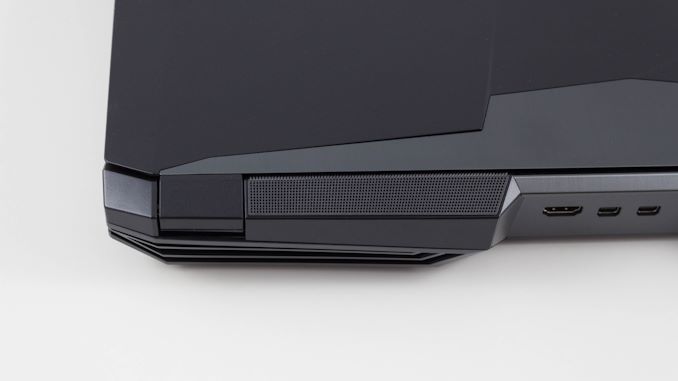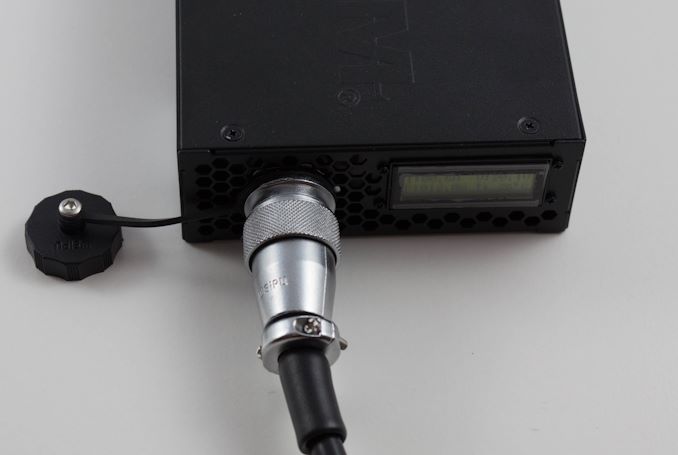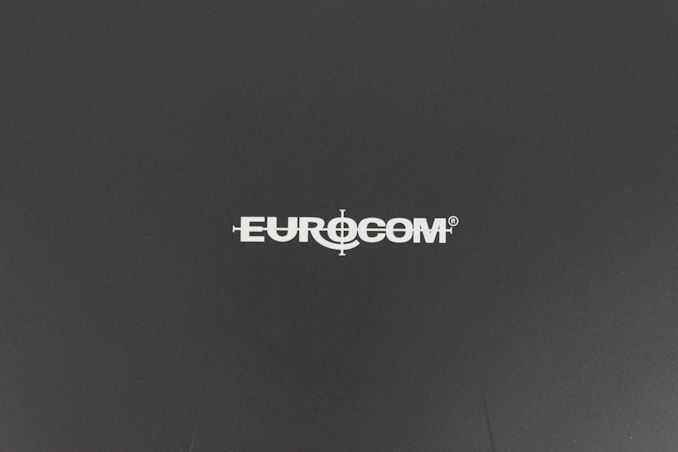The Eurocom Sky X7C (Clevo P775TM1-G) Gaming Laptop Review: True Desktop Replacement
by Brett Howse on August 5, 2019 8:00 AM ESTFinal Words
If you need absolute portable performance, look no further than the Eurocom Sky X7C. The latest generation of the Clevo based Desktop Replacement notebook from Eurocom offers fantastic performance compared to any other notebook around. 17.3-inch gaming notebooks tend to be desk-bound anyway, so this machine just goes all the way and becomes a small form factor desktop with a display and keyboard integrated.
What has perhaps been the most impressive in terms of performance is just how much quicker this notebook is than the last desktop class notebook we tested, which featured an at-the-time very speedy Core i7-6700K. Although Intel has been stuck with their Skylake architecture for much too long, the latest generation Coffee Lake processors are dramatically faster, partially based on the extra cores at play, and partially due to the much higher frequencies offered with the refinement to 14 nm over the last couple of years.
It is likely no surprise that this Eurocom Sky X7C walks all over the competition in terms of CPU performance thanks to the Core i9-9900K. If you want even more performance, Eurocom will assist by delidding and providing a wide-range of options for thermal paste and other tweaks. The included software makes it easy to tweak the CPU performance as well, and you can overclock if you’re into that sort of thing. The notebook seems to be able to handle the extra power demands of a desktop CPU without any real issues, other than the added noise. There was no thermal throttling detected under load at all.
The RTX 2080 continues to be the quickest GPU available in a notebook, and thanks to the extra CPU grunt it pulls its lead even further in games that were CPU bound, such as Far Cry 5. In GPU bound games, performance is about the same, as expected. It’s possible NVIDIA will offer the Super range in notebooks at some point in the future, but it does seem unlikely with the extra power draw the Super cards require, so for the foreseeable future, the RTX 2080 will likely rule the roost.
One of the biggest benefits of choosing a notebook such as this is the customization available. Most notebooks come in one of several different configurations, and what you see is what you get, but Eurocom offers a massive number of options to configure the notebook exactly as you need it, whether for absolute performance, or to fit in a budget.
Going into this review, there weren’t going to be a lot of surprises in terms of the notebook design and construction. We’ve seen Clevo based notebooks in the past, and the thick plastic exterior, the average keyboard and trackpad, and the somewhat plain design are all part and parcel of the experience, and this latest generation offered no surprises there. There were some nice new design tweaks though, such as the speakers being available on the rear hinge, allowing them to be used when the notebook is closed, but compared to the all-aluminum chassis of most of the big gaming laptop manufacturers, and things like the per-key RGB SteelSeries keyboards that MSI employs, the Clevo-based unit can’t measure up. However where it surpasses those devices is not only in outright performance, but performance per dollar as well.
If there was one major disappointment with the Eurocom Sky X7C, it was the 2560x1440 120 Hz TN display, but this was a conscious choice to see how it stacks up against the impressive 1920x1080 144 Hz IPS we’ve seen in a couple of other notebooks already. Clearly the latter panel is a better choice, especially with G-SYNC, and the RTX 2080 can game at 1920x1080 with framerates to keep the 144 Hz panel going nicely. If you do want a higher resolution for desktop applications, Eurocom also offers a 3840x2160 60 Hz IPS which would fit that bill, but if you’ve not had a chance to game on a high-refresh display, it really is a great experience especially when you have the hardware to power it.
Overall, Eurocom offers a great package in the Sky X7C. It offers the most performance possible in a single GPU notebook, at a price well below most of the competition. It is completely function over form, and it fills that job perfectly. As an owner, you also get the benefit of a lot of expandability and upgradability that you don’t get with a typical notebook, from not only the hard drives and memory, but also being able to change the CPU, and even the GPU, although not quite as easily, since you’d have to get a compatible MXM3 card, but they are available. If you laugh in the face of aluminum laptops, shun the thin and light crowd, and just want absolute performance, definitely check this model out. You won’t be disappointed.














46 Comments
View All Comments
DanNeely - Monday, August 5, 2019 - link
It's good to see that 1440p laptop screens aren't dead yet (4k is overkill for high DPI uses) even if this model gives a rather poor showing.anactoraaron - Monday, August 5, 2019 - link
$4,000 machine with literally the cheapest display they could find. Just embarrassing.airdrifting - Monday, August 5, 2019 - link
While it might be equipped with a desktop 9900K, it will never run the same speed and temperature as desktop counter parts. 9900K is notorious to overheat and I have seen it easily hit high 90C during Realbench with many motherboards WITHOUT overclocking using out of the box default settings (AIO liquid cooling), good luck getting it to run inside a tiny laptop. I have to manually lower voltage on most motherboards just to keep 9900K under 80C full load since most motherboards set like a ridiculous 1.2-1.3V voltage by default.MrRuckus - Monday, August 5, 2019 - link
If you read the article you would see they did exactly that. Loaded down the proc and were hitting 87c under load. Maintaining 4100-4200Mhz is very commendable in a laptop form factor. There could be more performance to be had by undervolting the Proc. As you say you do it on a desktop, it goes double for a laptop and can do wonders for throttling if there is any present. 80-90c is par for the course on Laptops that are desktop replacements.airdrifting - Tuesday, August 6, 2019 - link
"Maintaining 4100-4200Mhz is very commendable in a laptop form factor." 9900K on desktop Z390 motherboards is able to maintain 4.7GHz all core turbo. Now go back to read what I said in the very first sentence: "While it might be equipped with a desktop 9900K, it will never run the same speed and temperature as desktop counter parts." 4.1GHz < 4.7GHz, point proven.eastcoast_pete - Monday, August 5, 2019 - link
Thanks Brett! I have a soft spot for these DTRs (I like the even older name for them: luggables). I wonder if Clevo&Co. could come up with a true hybrid design: portable notebook format with socketed CPU, and the main second GPU in a docking station with integrated large PSU, connected via a PCIE3-16 (or PCIE4) snap-in connector, all in a case with a handle. That would give the graphics more thermal headroom, and avoid the potential bottleneck of running the dGPU over TB3. And, with an optional smaller, maybe GTX dGPU card on board, the laptop itself would still be quite capable.MrRuckus - Monday, August 5, 2019 - link
I think TB3 is going to be your best bet. I dont think external PCIe is going to be a thing due to length limitations and a needed external connector of some kind. The ribbon connectors aren't exactly made for unplugging and plugging in 100's of times. They have people who have done it, but the implementation is pretty wonky and you gotta have access to a Wifi card slot to do it. If I remember right they are also limited to PCIex1 so the difference between that and thunderbolt, thunderbolt can actually be faster. Just better off getting a laptop with a true thunderbolt 3.0 slot that can push 40gbps = PCIex4. Maybe Thunderbolt 4 will offer a true pound for pound replacement and get the throughput closer to 100% instead of the 70-80% now on external GPUs.imaheadcase - Monday, August 5, 2019 - link
Um no laptop is a gaming desktop replacement.You literally showed it wasn't by the specs. THe price is insanely expensive, and the screen is laughable.
bennyg - Tuesday, August 6, 2019 - link
It's not cheap. The particular panel has just been plagued with issues since it was first put in these 17" models in 2015/2016. The original B173QTN01.0 had horrible banding on alternating rows of pixels and the individual panels are quite variable. This would be a 1.2 or 1.4 revision I'm guessing. A colour calibration is necessary for this panel in particular. But its the only >1080p 120Hz out there.I have a P870DM3 with the same 17" 4K IPS panel that's an option for this P775, being 400nit 95% gamut and good colour accuracy it's the content creation and general beautifulness option, but it's transition of >20ms is not great for fast games.
bennyg - Tuesday, August 6, 2019 - link
No idea how my reply got here, it was to the guy bagging the "cheap" panel on about page 4 of the comments.Same old stuff going on in the comment section at AT....